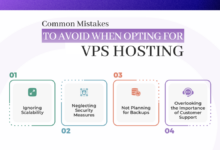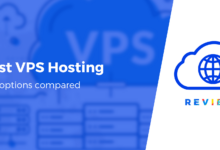Optimizing Your VPS for Maximum Speed and Performance
Optimizing Your VPS for Maximum Speed and Performance is crucial for ensuring a smooth and efficient online experience. This guide delves into the multifaceted process of enhancing your Virtual Private Server’s capabilities, from selecting the right provider and configuring server settings to optimizing databases, web servers, and integrating a Content Delivery Network (CDN). We’ll explore strategies for maximizing performance, bolstering security, and proactively managing potential bottlenecks. By following these steps, you can significantly improve your VPS’s speed and reliability, leading to a better user experience and increased overall efficiency.
We will cover key areas including choosing the right VPS provider based on performance and location, optimizing server configurations, database optimization techniques, web server tuning, CDN integration for enhanced speed and availability, and implementing robust security measures. Furthermore, we’ll explore essential monitoring and troubleshooting methods, load balancing strategies for handling increased traffic, and the advantages of utilizing SSD storage. This comprehensive approach ensures a holistic improvement in your VPS’s performance.
Choosing the Right VPS Provider
Selecting the optimal VPS provider is crucial for achieving peak performance. The right provider offers a robust infrastructure, reliable performance guarantees, and a server location that minimizes latency for your target audience. Failing to carefully consider these factors can significantly impact your VPS’s speed and overall efficiency.
Network Infrastructure and Performance Guarantees
Different VPS providers utilize varying network infrastructures. Some providers leverage Tier 1 networks, offering superior bandwidth, lower latency, and enhanced reliability. Others may rely on less robust networks, potentially resulting in slower speeds and increased downtime. Performance guarantees, such as uptime SLAs (Service Level Agreements), are also critical. A strong SLA assures you of a consistently available and performant service. When comparing providers, carefully examine their network topology, bandwidth capabilities, and the specific terms of their uptime guarantees. Look for providers with transparent reporting on network performance and a history of meeting their commitments. For example, a provider boasting a 99.99% uptime SLA is generally considered more reliable than one offering only 99%.
Server Location and Latency Minimization
Server location plays a pivotal role in minimizing latency. Latency, the delay in data transmission, directly impacts the speed at which your website or application loads. Choosing a server location closer to your target audience significantly reduces latency, resulting in faster loading times and an improved user experience. For example, a user in Europe will experience significantly faster loading times from a European-based server compared to one located in the United States. Consider the geographical distribution of your users when selecting a server location. Providers often offer servers in multiple data centers globally, allowing you to strategically position your VPS for optimal performance.
VPS Provider Comparison
The following table compares key features of three popular VPS providers. Note that pricing and specific configurations can vary, and this table represents a snapshot at a particular point in time. It’s essential to check the provider’s website for the most up-to-date information.
| Feature | Provider A (Example) | Provider B (Example) | Provider C (Example) |
|---|---|---|---|
| CPU | 2 vCPUs | 4 vCPUs | 1 vCPU |
| RAM | 4 GB | 8 GB | 2 GB |
| Storage | 50 GB SSD | 100 GB NVMe | 25 GB SSD |
| Bandwidth | 1 TB | 2 TB | 500 GB |
Optimizing Server Configuration
Optimizing your VPS’s server configuration is crucial for achieving peak performance. This involves fine-tuning various aspects of your operating system, from kernel parameters to file system choices. Even seemingly minor adjustments can significantly impact your VPS’s speed and responsiveness, leading to a smoother user experience and improved application performance. This section details key configuration optimizations to enhance your VPS.
Operating System Kernel Parameter Optimization
Optimizing kernel parameters allows you to fine-tune how your operating system manages resources, directly affecting performance. Incorrectly setting these parameters can lead to instability or reduced performance, so careful consideration and testing are vital. Modifying these values requires root privileges. Always back up your system before making changes.
- Increasing Network Buffer Sizes: Larger network buffer sizes can improve throughput for network-intensive applications. The specific parameters to adjust vary depending on your Linux distribution, but generally involve modifying values related to `net.core.so_max_conn`, `net.core.rmem_default`, and `net.core.wmem_default`. For example, you might increase `net.core.rmem_default` and `net.core.wmem_default` to values like 16777216 (16MB) for improved receive and transmit buffer sizes. The optimal values depend on your network configuration and application requirements. Testing is crucial to determine the best settings for your specific use case.
- Adjusting I/O Scheduler: The I/O scheduler determines how the operating system handles disk requests. The `cfq` (Completely Fair Queuing) scheduler is a common default, but others like `noop` (No Operation) or `deadline` may offer better performance depending on your workload. `noop` is generally faster for low-latency applications, while `deadline` is suitable for applications with high I/O demands. The choice depends on your specific needs and requires testing to identify the best option. You can change the scheduler using the `echo` command followed by the desired scheduler name and writing it to `/sys/block/sda/queue/scheduler` (replace `sda` with your disk device).
- Increasing File Descriptors: The number of file descriptors limits the number of simultaneous connections your system can handle. Increasing this limit can improve performance for applications that require many open files, such as web servers. This is typically adjusted by modifying the `ulimit` setting or the `nofile` parameter in `/etc/security/limits.conf`. For example, setting `hard nofile 65536` in `/etc/security/limits.conf` allows a maximum of 65536 open files per process.
Swap Space Configuration
Swap space acts as an extension of your RAM. When your system runs out of RAM, it uses swap space to store less frequently accessed data. While swap space can prevent system crashes, excessive swap usage can significantly slow down your VPS.
Properly configuring swap space involves finding a balance. Too little swap space can lead to system crashes, while excessive swap space can negatively impact performance due to the slower speed of disk access compared to RAM. A good rule of thumb is to have 1-2 times the amount of RAM as swap space, but this depends heavily on your application’s memory usage. Monitoring swap usage is crucial; if it’s consistently high, consider increasing RAM instead of relying heavily on swap. You can monitor swap usage using commands like `free -h` or through system monitoring tools. Tools like `vmstat` provide detailed memory and swap usage statistics.
File System Selection
The choice of file system significantly impacts VPS performance. Different file systems offer varying levels of performance, features, and reliability.
Ext4 is a robust and widely used file system that offers a good balance of performance and features. It’s a mature and reliable option suitable for most VPS use cases. Btrfs, on the other hand, offers advanced features like data integrity checks and snapshots but can sometimes introduce a slight performance overhead compared to ext4, especially on older hardware. For optimal speed on most VPS configurations, ext4 is generally recommended due to its proven performance and stability. The performance difference might be negligible in many cases, but for speed-critical applications, ext4 often provides a slight edge.
Database Optimization
A well-optimized database is crucial for achieving peak VPS performance. Slow database queries can significantly impact the responsiveness of your entire application. This section details strategies for enhancing database speed and efficiency. We’ll cover optimizing queries, indexing tables, and implementing caching mechanisms.
Optimizing Database Queries
Efficiently written database queries are fundamental to a fast-performing database. Poorly constructed queries can lead to excessive resource consumption and slow response times. Focusing on query structure and avoiding unnecessary operations are key.
For instance, consider the difference between a query that selects all columns (*), versus one that only selects the necessary columns. Selecting all columns (*), when you only need a few, forces the database to retrieve and process far more data than is required, increasing processing time. A more efficient approach involves specifying only the required columns.
Another common pitfall is using inefficient joins. Using `INNER JOIN` instead of `LEFT JOIN` or `RIGHT JOIN` when appropriate, will significantly reduce the number of rows processed. Likewise, avoid using `SELECT *` within subqueries; only select the necessary fields.
Regularly reviewing and optimizing your database queries using tools provided by your database management system (DBMS) such as query analyzers, is crucial. These tools provide valuable insights into query performance and highlight areas for improvement. Many DBMS offer query execution plans, which visualize how the database processes a query, enabling the identification of bottlenecks.
Indexing Database Tables
Database indexing significantly improves search speed by creating data structures that allow the database to quickly locate specific rows without scanning the entire table. Indexes are especially beneficial for frequently queried columns.
Consider a table storing user information, with columns like `user_id`, `username`, `email`, and `registration_date`. Indexing the `user_id` column (often a primary key) is usually a given, as it’s frequently used to retrieve specific user data. Indexing the `username` and `email` columns would also be beneficial, if these fields are frequently used in search operations. However, over-indexing can negatively impact write performance, so careful consideration is needed. Choosing the appropriate index type (B-tree, hash, full-text, etc.) based on the query patterns is also important.
The optimal number of indexes depends on your specific database schema and query patterns. Too few indexes can lead to slow searches, while too many can hinder write operations. Regularly analyzing query performance and adjusting indexes accordingly is crucial for maintaining optimal performance.
Caching Database Results
Database caching stores frequently accessed data in memory, reducing the need to repeatedly query the database. This significantly reduces server load and improves response times.
Various caching techniques exist, including using a dedicated caching server (like Memcached or Redis) or leveraging built-in caching mechanisms offered by many frameworks and database systems. These caching systems store data in memory, providing significantly faster access than querying the database directly. The data stored in the cache can be either complete query results or individual data elements.
Implementing a caching strategy involves identifying frequently accessed data and configuring your application to check the cache before querying the database. If the data is found in the cache, it’s returned immediately; otherwise, the database is queried, and the results are stored in the cache for future use. Proper cache invalidation strategies are also vital to ensure data consistency. For example, using time-to-live (TTL) settings or cache invalidation mechanisms triggered by database updates ensures the cache remains synchronized with the database.
Web Server Optimization
A well-configured web server is crucial for achieving optimal VPS performance. Choosing the right server software and meticulously optimizing its settings can significantly reduce loading times and improve the overall user experience. This section will explore best practices for configuring Apache and Nginx, the use of caching mechanisms, and a comparison of different caching strategies.
Apache and Nginx Configuration Best Practices
Efficient web server configuration involves several key areas. Properly adjusting settings like worker processes, connection limits, and caching mechanisms can drastically impact performance. Below are some best practices for both Apache and Nginx.
- Worker Processes/Threads: The number of worker processes (Apache) or worker threads (Nginx) should be carefully tuned to match the server’s CPU cores and anticipated load. Too few can lead to bottlenecks, while too many can consume excessive resources. Monitoring CPU usage and adjusting the number of processes/threads accordingly is essential. For example, a server with 4 cores might benefit from 4 to 8 worker processes, but this is dependent on the specific workload and application.
- Keep-Alive Connections: Enabling keep-alive connections allows multiple requests to be served over a single TCP connection, reducing the overhead associated with establishing new connections for each request. This significantly improves efficiency, especially for websites with many small resources.
- Connection Limits: Setting appropriate limits on the number of simultaneous connections the server can handle prevents resource exhaustion under heavy load. This limit should be balanced against the server’s capacity and the anticipated traffic volume.
- Gzip Compression: Enabling Gzip compression reduces the size of the data sent to the client’s browser, leading to faster download times and improved user experience. This is particularly beneficial for text-based content like HTML, CSS, and JavaScript.
- Caching Headers: Properly configuring caching headers (e.g., `Cache-Control`, `Expires`) allows browsers and intermediate caches (like CDNs) to store static assets (images, CSS, JavaScript) locally, reducing the load on the web server and improving loading times. These headers should specify appropriate cache durations based on the asset’s lifespan.
Caching Plugins and Modules
Caching is a powerful technique for significantly improving website loading times. Caching mechanisms store frequently accessed data in memory or on disk, reducing the need to repeatedly generate or fetch it from the database or other sources. Both Apache and Nginx offer various caching modules and plugins that can be integrated to achieve this. For example, Varnish Cache is a popular and highly effective HTTP accelerator that can be used in conjunction with either web server. Other examples include Redis and Memcached.
Comparison of Web Server Caching Mechanisms
Different caching mechanisms offer distinct advantages and disadvantages. Understanding these differences is crucial for selecting the most appropriate strategy for a given application.
- Page Caching: This caches entire web pages, including their dynamic content. It is highly effective for static or infrequently changing content, but less suitable for highly dynamic pages that require frequent updates. The cached pages are served directly from the cache, bypassing the application logic and database.
- Opcode Caching: This caches the compiled bytecode of PHP scripts (or other scripting languages). It avoids the overhead of recompiling scripts on each request, significantly improving performance, particularly for applications with complex scripts. Popular opcode caches include OPcache (for PHP) and similar mechanisms for other languages.
- Object Caching: This caches individual objects or data fragments, such as database query results or API responses. It’s useful for frequently accessed data that is relatively independent of the overall page context. Memcached and Redis are commonly used for object caching.
Content Delivery Network (CDN) Integration
Integrating a Content Delivery Network (CDN) is a crucial step in optimizing your VPS for maximum speed and performance. A CDN significantly enhances website speed and availability by distributing your website’s content across multiple servers globally. This reduces latency for users, leading to a better user experience and improved search engine rankings.
A CDN works by caching static content, such as images, CSS files, and JavaScript files, on servers located closer to your users geographically. When a user requests this content, the CDN delivers it from the nearest server, resulting in faster loading times. This offloads significant traffic from your VPS, improving its overall performance and stability.
CDN Integration Strategies
Choosing the right CDN integration strategy depends on your specific needs and technical capabilities. Several approaches exist, each offering different levels of complexity and control.
- Using a CDN provider’s plugin or module: Many popular CDN providers offer plugins or modules that seamlessly integrate with various content management systems (CMS) and web server platforms. This method often requires minimal technical expertise and is suitable for users with limited technical skills. For example, a WordPress website could easily integrate with a CDN using a plugin that automatically pushes static assets to the CDN’s edge servers.
- Manual configuration through your web server: This approach provides more granular control over the CDN integration process. It typically involves configuring your web server (e.g., Apache or Nginx) to use the CDN’s domain name for serving static assets. This requires a stronger understanding of web server configuration but allows for more customized setups. This method might involve using specific directives within your web server’s configuration file to redirect requests for specific file types to the CDN.
- Using a CDN control panel: Some CDN providers offer a dedicated control panel to manage your CDN configuration, allowing for easy management of cached content, purging outdated files, and monitoring performance metrics. This approach simplifies the management of your CDN, providing a user-friendly interface for managing various aspects of your CDN setup.
CDN’s Impact on Server Load
CDNs significantly reduce the load on your VPS by serving static content from their geographically distributed servers. This frees up your VPS resources to handle dynamic content, database queries, and other computationally intensive tasks. For instance, a website receiving 10,000 daily visits with a significant amount of static content might experience a substantial reduction in server load by offloading 80% of the requests to a CDN, allowing the VPS to focus on the remaining 20% of dynamic requests. This results in improved response times and prevents server overload, ensuring consistent website performance even during traffic spikes. The reduction in server load directly translates to cost savings as you may require less powerful VPS resources.
Security Hardening
A robust security posture is paramount for maintaining optimal VPS performance. Unpatched vulnerabilities and inefficient security configurations can significantly drain resources, leading to slowdowns and even complete system failures. Proactive security hardening minimizes these risks, ensuring your VPS remains both secure and efficient.
Security vulnerabilities often manifest as open ports, weak passwords, outdated software, and insufficient firewall rules. These weaknesses can be exploited by malicious actors, leading to denial-of-service attacks, data breaches, and resource exhaustion, all negatively impacting your VPS’s speed and performance.
Common Security Vulnerabilities and Mitigation Strategies
Addressing common vulnerabilities requires a multi-faceted approach. For instance, leaving unnecessary ports open exposes your server to potential attacks. Similarly, weak or default passwords are easily cracked, providing unauthorized access. Outdated software often contains known vulnerabilities that attackers can exploit. Finally, improperly configured firewalls can leave your system exposed.
- Vulnerability: Open and Unnecessary Ports. Mitigation: Close all unnecessary ports using your firewall. Only open ports absolutely required for your applications and services. Regularly review open ports to ensure they remain necessary.
- Vulnerability: Weak Passwords. Mitigation: Employ strong, unique passwords for all user accounts and services. Consider using a password manager to generate and securely store complex passwords. Enable two-factor authentication (2FA) wherever possible.
- Vulnerability: Outdated Software. Mitigation: Regularly update your operating system, applications, and libraries to the latest versions. Enable automatic updates where feasible, and prioritize patching known vulnerabilities immediately upon release.
- Vulnerability: Insufficient Firewall Rules. Mitigation: Configure your firewall to allow only necessary inbound and outbound traffic. Implement strict rules based on IP addresses, ports, and protocols. Regularly review and update your firewall rules as your needs change.
Firewall Configuration for Enhanced Security and Performance
Proper firewall configuration is crucial for balancing security and performance. Overly restrictive rules can impede legitimate traffic, while lax rules leave your system vulnerable. The goal is to create a finely tuned firewall that effectively blocks malicious traffic while allowing necessary connections.
A well-configured firewall should utilize both stateful inspection and packet filtering. Stateful inspection tracks the state of network connections, allowing legitimate return traffic while blocking unsolicited connections. Packet filtering examines individual packets based on criteria such as source/destination IP addresses, ports, and protocols. Using both techniques provides a layered approach to security. For example, a rule might allow SSH connections only from specific IP addresses and block all other SSH attempts. Another rule might allow HTTP traffic on port 80 but block all other traffic on that port. Regularly reviewing and updating firewall rules is essential to adapt to evolving threats and application requirements.
Regular Security Updates and Patching
Regular security updates and patching are essential for mitigating vulnerabilities and maintaining a secure VPS. Operating system vendors and application developers regularly release security patches to address newly discovered flaws. Ignoring these updates leaves your system vulnerable to exploitation.
Regular patching is not merely a security best practice; it’s a critical component of maintaining VPS performance and uptime.
Implementing an automated patching system can streamline this process and ensure that updates are applied promptly. This system should include regular scans for vulnerabilities, automated downloads and installations of updates, and post-update system checks to ensure everything is functioning correctly. Testing updates in a staging environment before deploying them to production can help minimize disruptions.
Monitoring and Troubleshooting
Proactive monitoring and efficient troubleshooting are crucial for maintaining optimal VPS performance. Regularly assessing key metrics and understanding potential bottlenecks allows for swift intervention, minimizing downtime and ensuring a consistently smooth user experience. This section details tools, techniques, and strategies for effective monitoring and troubleshooting of your VPS.
VPS Performance Monitoring Tools and Techniques
Several tools and techniques enable comprehensive monitoring of your VPS’s performance. These tools provide real-time insights into resource utilization, helping identify potential issues before they impact performance. Effective monitoring involves tracking key metrics such as CPU usage, memory usage, and network traffic.
- System Monitoring Tools: Tools like
htop(a text-based interactive process viewer),top(another text-based system monitor), andvmstat(provides statistics on virtual memory) offer real-time insights into CPU and memory usage.iftopandtcpdumpprovide network traffic analysis. - Monitoring Software: Dedicated monitoring software such as Nagios, Zabbix, and Prometheus provide a centralized dashboard for visualizing key metrics and setting up alerts for critical thresholds. These systems can monitor a wide range of metrics, generate reports, and automatically trigger notifications when problems arise.
- Cloud Provider Monitoring: Most cloud providers (AWS, Azure, Google Cloud) offer built-in monitoring tools integrated with their platforms. These tools provide comprehensive dashboards and alerts, often with detailed visualizations and historical data analysis.
Common Performance Bottlenecks and Resolution Strategies
Understanding common performance bottlenecks is key to effective troubleshooting. These bottlenecks can manifest in various ways, impacting different aspects of your VPS’s performance. Identifying and resolving these issues is essential for maintaining optimal speed and efficiency.
- High CPU Usage: High CPU usage can be caused by resource-intensive processes, poorly optimized code, or a lack of sufficient CPU resources. Solutions involve identifying and optimizing CPU-intensive processes, upgrading to a VPS with more CPU cores, or employing caching mechanisms.
- High Memory Usage: Memory leaks, inefficient code, or insufficient RAM can lead to high memory usage. Solutions involve optimizing memory usage within applications, upgrading to a VPS with more RAM, and using swap space judiciously (while understanding its performance implications).
- Network Bottlenecks: Slow network speeds or high network latency can be caused by network congestion, insufficient bandwidth, or inefficient network configuration. Solutions involve investigating network traffic patterns, upgrading to a VPS with higher bandwidth, optimizing network configuration, and using a CDN.
- Slow Database Queries: Inefficient database queries can significantly impact application performance. Solutions include optimizing database queries, using appropriate indexes, and employing database caching mechanisms.
Proactive Performance Issue Prevention Strategies
Proactive measures are essential for preventing performance issues before they impact your VPS. Regular maintenance, optimization, and monitoring are crucial components of a robust performance management strategy.
- Regular Software Updates: Keeping your operating system and applications up-to-date is critical for patching security vulnerabilities and improving performance. Regular updates often include performance optimizations and bug fixes.
- Load Testing: Performing load tests simulates real-world traffic to identify potential bottlenecks under stress. This allows for proactive optimization and capacity planning.
- Regular Backups: Regular backups provide a safety net in case of unexpected failures. They allow for quick recovery and minimize downtime.
- Resource Monitoring Alerts: Setting up alerts for critical resource thresholds (e.g., CPU usage exceeding 90%) allows for prompt intervention before performance degradation becomes noticeable to users.
Load Balancing and Scaling
As your VPS gains popularity and handles increasing traffic, maintaining optimal performance becomes crucial. Load balancing is a critical technique for distributing incoming traffic across multiple servers, preventing any single server from becoming overloaded and ensuring consistent response times for your users. This prevents service disruptions and enhances the overall user experience. Effective scaling, often implemented in conjunction with load balancing, allows your infrastructure to adapt seamlessly to fluctuating demands.
Load balancing distributes network or application traffic across multiple servers. This prevents overload on any single server, improving responsiveness and reliability. Different techniques are employed depending on the specific needs and architecture of the system. The choice of technique impacts factors like performance, cost, and complexity.
Load Balancing Techniques
Several techniques exist for distributing traffic, each with its own strengths and weaknesses. Choosing the right technique depends on factors such as the type of application, the anticipated traffic volume, and the budget.
- Round Robin: This is a simple method that distributes requests sequentially to each server in a predefined order. It’s easy to implement but may not be efficient if servers have different processing capabilities.
- Least Connections: This method directs new requests to the server with the fewest active connections. This is more efficient than round robin as it prioritizes servers with available resources.
- IP Hashing: This technique uses the client’s IP address to consistently direct requests to the same server. This is useful for applications that require session persistence, but it can lead to uneven load distribution if certain IP addresses generate significantly more traffic.
- Weighted Round Robin: This method extends the basic round robin approach by assigning weights to each server based on its processing capacity. Servers with higher weights receive a proportionally larger share of requests.
A Load-Balanced VPS Setup
Consider a scenario with three VPS servers (Server A, Server B, Server C) acting as web servers. A load balancer sits in front of these servers. All incoming traffic first reaches the load balancer. The load balancer then uses a chosen algorithm (e.g., least connections) to direct each incoming request to one of the three servers. If one server becomes overloaded, the load balancer dynamically adjusts the distribution to ensure that the remaining servers handle the increased load. This setup provides redundancy and high availability, as the failure of a single server doesn’t interrupt service. The diagram would show a box labeled “Load Balancer” with arrows pointing to three boxes labeled “Server A,” “Server B,” and “Server C,” representing the distribution of traffic. All incoming client requests would be represented by arrows pointing to the load balancer box.
Utilizing SSD Storage
The choice of storage significantly impacts your VPS’s performance. Solid State Drives (SSDs) offer a substantial speed advantage over traditional Hard Disk Drives (HDDs), leading to faster boot times, quicker application loading, and improved overall responsiveness for your server. This section will explore the benefits of SSDs, the process of migrating your data, and the impact of different SSD configurations.
SSDs use flash memory to store data, enabling significantly faster read and write speeds compared to HDDs, which rely on spinning platters and read/write heads. This difference translates to drastically improved performance in various aspects of VPS operation.
SSD versus HDD Performance Comparison
SSDs boast considerably faster random read/write speeds than HDDs. This is crucial for database operations and other applications that require frequent access to small data chunks. Sequential read/write speeds are also much higher on SSDs, beneficial for large file transfers and backups. For example, an SSD might achieve read speeds of 500 MB/s or more, while an HDD might only reach 150 MB/s or less. The lower latency (the time it takes to access data) of SSDs further enhances performance, resulting in noticeably quicker response times for applications and users. This translates to a smoother user experience and improved overall efficiency of your server. The lack of moving parts in SSDs also contributes to greater reliability and durability compared to HDDs, which are susceptible to mechanical failures.
Migrating Data to an SSD
Migrating your data to an SSD involves several steps. First, ensure you have a sufficient-sized SSD for your data. Then, you can use various methods for migration, including cloning the existing drive, or manually copying files. Cloning tools create an exact copy of your existing HDD onto the SSD, preserving your operating system and applications. This method is generally the fastest and easiest. Manual copying involves transferring files from the HDD to the SSD using your operating system’s file manager or command-line tools. This approach offers more control but requires more time and care to ensure all files are transferred correctly. Regardless of the method, it’s crucial to back up your data before starting the migration process to prevent data loss. After the migration, you will need to update your system’s boot configuration to point to the new SSD.
Impact of SSD Configuration (RAID)
RAID (Redundant Array of Independent Disks) configurations combine multiple SSDs to enhance performance, reliability, or both. RAID 0 offers the highest performance by striping data across multiple drives, but it lacks redundancy, meaning a single drive failure results in data loss. RAID 1 provides mirroring, where data is duplicated across drives, ensuring high reliability but lower performance than RAID 0. RAID 10 combines striping and mirroring for both high performance and redundancy. The choice of RAID configuration depends on your priorities: prioritizing speed, reliability, or a balance of both. For example, a web server focused on high throughput might benefit from RAID 0, while a database server requiring high availability might use RAID 10. Implementing RAID requires careful consideration and understanding of its implications, including potential performance overhead and the cost of multiple SSDs.
Final Summary
By implementing the strategies outlined in this guide, you can significantly enhance the speed and performance of your VPS. From careful provider selection and server configuration optimization to database and web server tuning, and the strategic integration of a CDN, every step contributes to a more responsive and reliable online presence. Remember that ongoing monitoring and proactive troubleshooting are vital for maintaining optimal performance and addressing potential issues before they impact your users. Investing time in these optimizations will yield significant returns in the form of improved user experience, increased efficiency, and ultimately, a more successful online venture.









